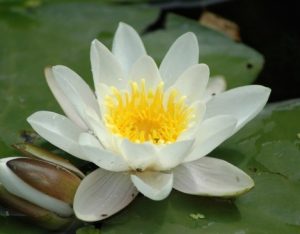Water lily
Home " Floating plants " Water lily
Water lily in your pond. The pros and cons.
A Water Lily can be a fantastic sight in a pond. Blooming in summer, this water plant produces beautiful white or pink flowers on large green leaves. These fit into the decor of a garden or they add that little extra to the look of a building.
However, many people think that the water lily also has many benefits for water quality, but that is not so bad. Water lilies tend to proliferate quite a bit. Placement in a sturdy basket can prevent this somewhat, but it is something to keep an eye on. The Water Lily's large leaves provide shade. Incidentally, this is a positive point; the floating algae in the pond have less sunlight available and will therefore grow less. A disadvantage is that, if the pond is far dense with Water Lily leaves, this is also at the expense of the submerged aquatic plants.

What types of water lilies are there?
The white Water Lily is fairly common in the Netherlands and prefers to grow in still or slow-flowing water that is up to about 1.5 metres deep. The seeds from the fruit, which ripens underwater and is shaped like a bottle, are dispersed through the water.
Besides the White Water Lily, there are a number of colours available in the Netherlands and Belgium.
Are there alternatives to water lilies?
Alternatives to the Water Lily are certainly available, although they cannot be placed too deep. Pikeweed is a good example.
This riparian plant can provide a beautiful look in ponds that are not too deep. Arrowweed and Water Thistle also produce beautiful flowers and are something else again!
